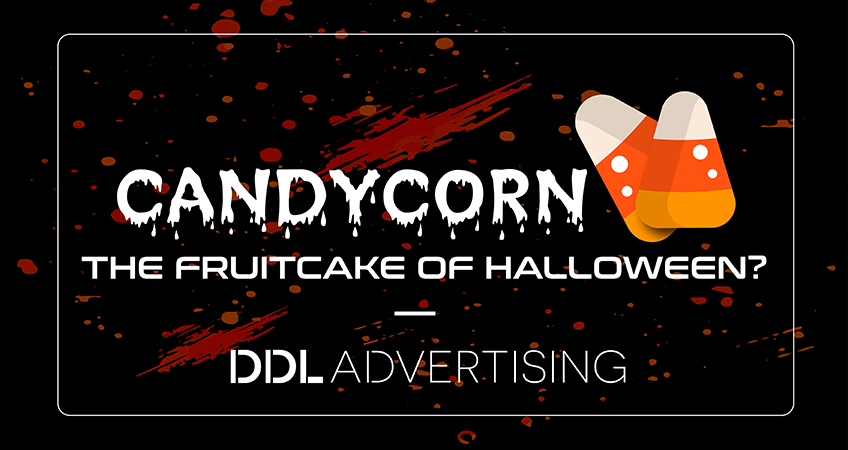When you think Halloween, several things come to mind. Besides jack-o-lanterns and costumes, candy is what many associate with the holiday; most iconic of which is candy corn. Only at this time of the year is it widely available and most Halloween decorations incorporate it in some way. In fact, almost 35 million pounds of candy corn are produced each year. Some consider candy corn to be the fruitcake of Halloween, a food that’s forever associated with the holiday but is very much a “love it or hate it” for most people. Anecdotally, most people dislike it, often citing its waxy taste. DDL, on the other hand, loves candy corn and it’s one of the things we look forward to most this time of year. So let’s find out exactly where they came from in the first place.


Who Invented Candy Corn?
While the history of this treat isn’t completely clear, George Renninger of the Wunderlee Candy Company is often credited with the creation of it in the 1880s. According to the National Confectioners Association, his company was the first to sell them. The treat wouldn’t gain popularity until the Goelitz Candy Company (now known today as Jelly Belly) started producing it in 1898. It was initially sold and marketed under the name “chicken feed,” since at the time most Americans considered corn to be strictly animal feed. Even after changing the name to what we currently know it as, roosters continued to be a major part of Goelitz’s branding for the product throughout the early 20th Century. The candy was originally marketed year-round without any ties to a particular season or holiday. With the growth in popularity of Halloween after World War II, however, it became solely associated with the holiday due to its color scheme and ties to the country’s agrarian roots.
What’s Candy Corn Even Made Of?
So what even makes up this Halloween fruitcake anyway? Manufacturers today make it by filling kernel-shaped trays with cornstarch and is then filled with white syrup made up of sugar and corn syrup. Each space in the mold is colored with a different color of food coloring in order to create their iconic tri-color design. The mixture is then cooled for 24 hours until it’s solid. After this, a confectioner’s glaze is applied to the candy and is then packaged together in bags. Here are some key ingredients found in candy corn:
- Sugar
- Corn syrup
- Confectioner’s Glaze
- Salt
- Dextrose
- Gelatin
- Sesame Oil
- …and more!
What About Now?
Today, candy corn has evolved from the just the standard, triangular candy with the same flavor from decades ago. In addition to numerous amounts of candy corn-based merchandise from decorations and clothing to accessories and even vape juice, some manufacturers have begun to experiment with new flavors all together. Some of these flavors include Apple Pie, Chocolate Peanut Butter, and Pumpkin Spice. Candy corn has even made an effort to expand its reach into the Christmas season as well with flavors like Candy Cane, Gingerbread, and even Eggnog. Depending on one’s perspective, this expansion in flavors is either to cater to the crowd who just can’t get enough of candy corn or a move in order to convince those who despise the treat to give it another chance.

So Who Likes Candy Corn Then?
As mentioned previously, candy corn is very divisive amongst many. However, in a 2015 survey by Influenster that determined among each state’s favorite candy, candy corn was the favorite in Oregon, Wyoming, Tennessee, Texas, and South Carolina. According to Statista, 49% of consumers surveyed consider candy corn to be tasty with 23% saying it’s gross, and 21% stating that they don’t like it, but believe it is an important staple of Halloween. On the other hand, it was found to be the least appreciated candy among Gen X and Millennial Americans in a 2017 poll by Mashable.

What Does the Future Hold for The Fruitcake of Halloween?
The results of the Mashable poll seem to indicate a generational divide when it comes to the preference towards candy corn. Despite candy corn risking the loss of a significant demographic as they age out, manufacturers don’t appear to be worried. In an interview with Adweek, Jana Sanders Perry of Jelly Belly stated that the company has no plans to stop production at any point, explaining that they themselves are big candy corn fans alongside millions of consumers. During October 2017, candy corn accounted for a 40.17% share of total sales. Make sure candy corn is a part of your Halloween trick-or-treats! Check out our other Halloween blogs: 6 Helpful Halloween Tips from DDL and Happy Halloween Wishes from DDL!
Sources: Influenster, Statista, Mashable, Adweek

